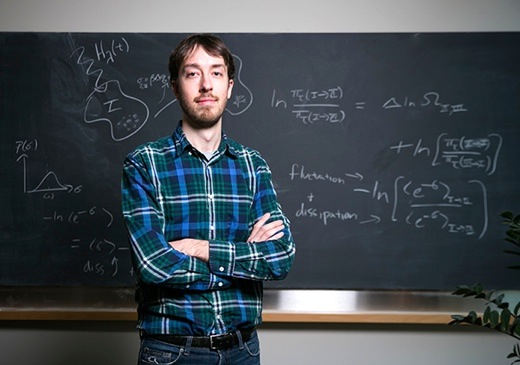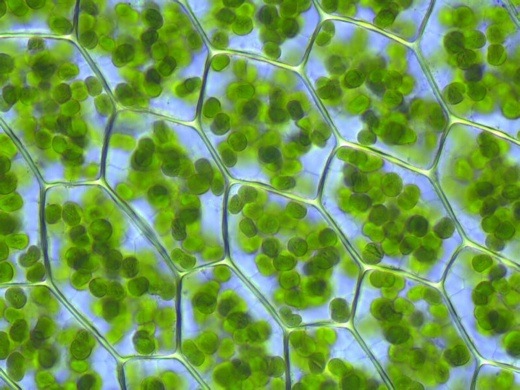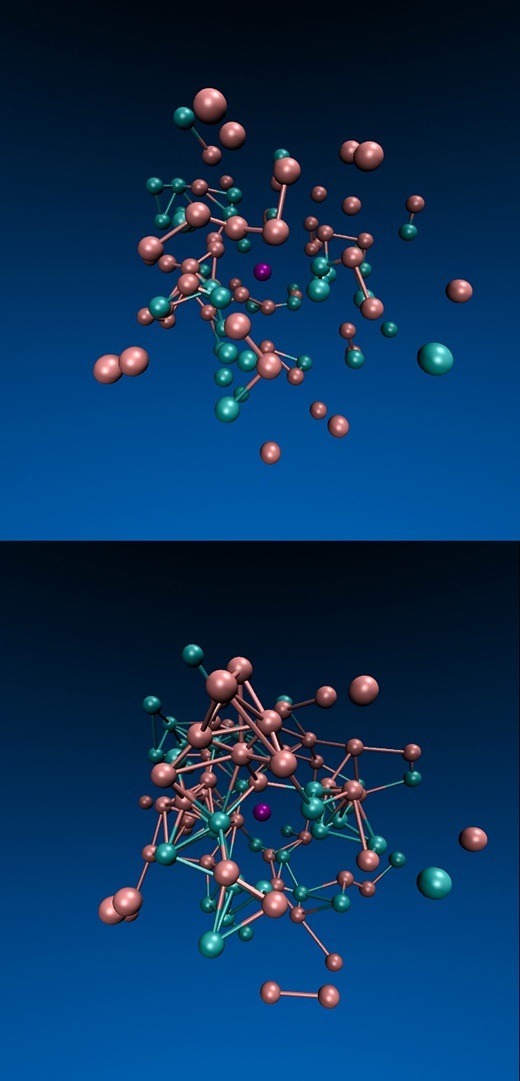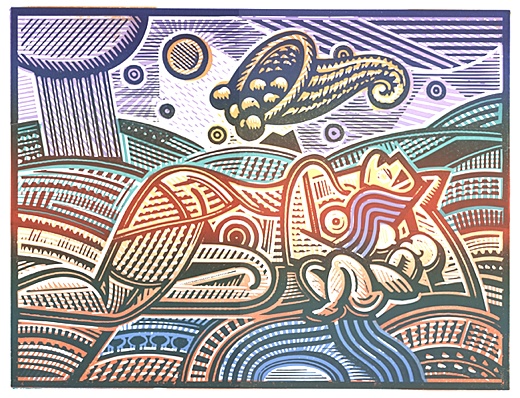SUBHEAD: Finding an happy outdoor chicken that lays a reasonable amount of eggs, breeds and is tasty roasted.
By Eatwell Farms on 8 August 2014 for CUESA -
(http://www.cuesa.org/article/breeding-better-chicken-eatwell-farm)

Image above: Nigel Walker of Eatwell Farms with chicks he hoping will "do it all". From original article.
While many conscientious eaters go out of their way to purchase pasture-raised eggs laid by happy chickens, it’s a little-known fact that almost all eggs have a hidden cost: millions of baby male chicks are killed each year at the hatcheries that raise egg-laying hens. Even humane, organic egg producers are reliant on these large hatcheries.
“It’s a dirty little secret, isn’t it?” says farmer Nigel Walker of Eatwell Farm in Dixon, California, who has ordered thousands of Production Red chicks each year for his diversified organic farm.
“Many customers have asked me about this practice, and I’ve been very truthful with them,” he says. “I’ve always been uncomfortable with it, but I wasn’t able to find a good solution until now.”
Earlier this week, Eatwell Farm launched a crowdfunding campaign on the online platform Barnraiser to start a chicken breeding program, which aims to eliminate the farm’s reliance on hatcheries. “We want to step up to the next level because we think it’s the right thing to do,” says Nigel.
Live Fast, Die Young
Up until the last century, chickens were raised outdoors for the dual purpose of eggs and meat. Around the mid-twentieth century, breeders began to focus on developing specialized breeds for indoor industrial production. “These birds are selected to live in a house with 25,000 other birds with constant light and heat all year round,” Nigel says. “That’s not the environment we have in the fields.”
Popular meat breeds like the Cornish Cross have been bred for rapid growth, to the detriment of other characteristics such as longevity and disease resistance. “The average chicken in our country is processed [slaughtered] at 37 days,” says Jim Adkins, founder of the Sustainable Poultry Network in Old Fort, North Carolina. “If you and I grew at that rate, we would be 260 pounds by the time we’re two years old.”
Modern layers like the White Leghorn and Rhode Island Red are also bred for productivity: they lay 250 to 300 eggs a year. After about 14 months, they stop producing, making them virtually useless to a farmer, except for processing into chicken stock.
Because laying breeds don’t grow fast enough to be profitable for meat production, egg farmers have no incentive to raise the males, making them reliant on the hatcheries to replenish their flock every year. Once the chicks are sexed at the hatchery, the males are killed—ground alive, gassed, or otherwise disposed of.
Out of the Hatchery
A couple years ago, Nigel attended an Acres USA farming conference in Kentucky where he met Jim Adkins, who opened his eyes to a different way of raising chickens.
A bird enthusiast and hobbyist who had raised more than 50 different breeds of chickens, ducks, geese, and turkeys, Jim has seen all sides of the poultry industry. For several years, he was a supervisor at a large-scale turkey operation, where he witnessed the unsustainability of modern poultry breeding. “I thought, ‘Something is wrong with this picture,’” he says.
In 2010, he founded the Sustainable Poultry Network, with the goal of restoring heritage breeds and training farmers to humanely and sustainably breed their own flocks. “We are on a mission to put the old breeds of poultry back to work,” he says. While such birds may produce fewer eggs and put on pounds more slowly than modern breeds, they tend to be more healthy, resilient, and productive in the long run.
Nigel hired Jim as a consultant to help him start a dual-purpose breeding program at Eatwell Farm. Eatwell is one of the largest operations Jim has worked with so far, but interest is growing.
“Nigel is definitely on the forefront,” says Jim. “To be able to breed your flock so it’s sustainable is a lot of hard work.”
Starting from Scratch
For Eatwell, Jim recommended the Black Australorp, a dual-purpose breed with dark, shiny feathers. Last spring, Nigel bought 200 chicks (half male, half female) from a hatchery in North Carolina. When the Australorps arrived, they instantly took to the pasture and were more vibrant and alert than the Production Reds Nigel was accustomed to.
Jim chose seven males and 35 females to start the breeding families. “It’s a bit like heirloom tomatoes,” say Nigel, who is well-versed in saving seeds. “You select the ones that do really well in your environment.”
As the flock grows, the birds must be carefully tracked. Each time a hen goes to lay an egg, a door closes behind her (in what is called a trap nest) so that the bird and her egg can be recorded by Eatwell staff. The best of the best will be selected for hatching.
Nigel’s hope is that Eatwell will be able to replace their flock of nearly 3,000 Production Reds within the next two years, possibly sooner, and the farm will no longer have to purchase chicks from hatcheries. Whereas the Production Reds lay for only about one year, the Australorps are productive for at least three. The males will be raised to maturity and processed for meat, providing additional income for the farm. Nigel may also be able to sell his locally adapted Australorps to other farms in the area.
Raising the Barn
Completing such an ambitious project takes time and money that is not currently in the farm’s budget. The $20,000 requested on Barnraiser will help cover the costs of infrastructure, from incubators and nesting boxes to labor and consulting fees. (Pending additional funding, Nigel and Jim hope to develop a mobile app to help organize the breeding data and track flocks remotely, a tool that could be used by breeders across the country.)
This is not the first time Nigel has turned to his community for help in starting a new project. The farm originally set up its egg operation with financial help from his CSA members, who were demanding organic eggs. They quickly raised and loaned him $25,000, which was later paid back in full.
Today, the income from Eatwell’s eggs barely covers the costs of production, but chickens play an invaluable role in the farm’s ecosystem, having eliminated the need for compost and external fertilizers.
“The real core issue here is getting animals back on farms and out of these confinement operations,” says Nigel. “Yes, we want their eggs, and the meat is great, too, but the reason we have our chickens is that they eat the pasture and fertilize the ground. All our organic vegetables are grown with fertility from cover crops and chickens.”
He continues, “We’re trying to find a bird that can live outside, where it can express all of its chickenness, but still lay a very reasonable amount of eggs and make an absolutely tasty roast chicken.”
Look for Eatwell Farm at the Ferry Plaza Farmers Market on Saturdays. To learn more and support their fundraising campaign, visit Barnraiser.
Eatwell Farm photos by Jamie LeJeune and Eatwell Farm.
.
By Eatwell Farms on 8 August 2014 for CUESA -
(http://www.cuesa.org/article/breeding-better-chicken-eatwell-farm)

Image above: Nigel Walker of Eatwell Farms with chicks he hoping will "do it all". From original article.
While many conscientious eaters go out of their way to purchase pasture-raised eggs laid by happy chickens, it’s a little-known fact that almost all eggs have a hidden cost: millions of baby male chicks are killed each year at the hatcheries that raise egg-laying hens. Even humane, organic egg producers are reliant on these large hatcheries.
“It’s a dirty little secret, isn’t it?” says farmer Nigel Walker of Eatwell Farm in Dixon, California, who has ordered thousands of Production Red chicks each year for his diversified organic farm.
“Many customers have asked me about this practice, and I’ve been very truthful with them,” he says. “I’ve always been uncomfortable with it, but I wasn’t able to find a good solution until now.”
Earlier this week, Eatwell Farm launched a crowdfunding campaign on the online platform Barnraiser to start a chicken breeding program, which aims to eliminate the farm’s reliance on hatcheries. “We want to step up to the next level because we think it’s the right thing to do,” says Nigel.
Live Fast, Die Young
Up until the last century, chickens were raised outdoors for the dual purpose of eggs and meat. Around the mid-twentieth century, breeders began to focus on developing specialized breeds for indoor industrial production. “These birds are selected to live in a house with 25,000 other birds with constant light and heat all year round,” Nigel says. “That’s not the environment we have in the fields.”
Popular meat breeds like the Cornish Cross have been bred for rapid growth, to the detriment of other characteristics such as longevity and disease resistance. “The average chicken in our country is processed [slaughtered] at 37 days,” says Jim Adkins, founder of the Sustainable Poultry Network in Old Fort, North Carolina. “If you and I grew at that rate, we would be 260 pounds by the time we’re two years old.”
Modern layers like the White Leghorn and Rhode Island Red are also bred for productivity: they lay 250 to 300 eggs a year. After about 14 months, they stop producing, making them virtually useless to a farmer, except for processing into chicken stock.
Because laying breeds don’t grow fast enough to be profitable for meat production, egg farmers have no incentive to raise the males, making them reliant on the hatcheries to replenish their flock every year. Once the chicks are sexed at the hatchery, the males are killed—ground alive, gassed, or otherwise disposed of.
Out of the Hatchery
A couple years ago, Nigel attended an Acres USA farming conference in Kentucky where he met Jim Adkins, who opened his eyes to a different way of raising chickens.
A bird enthusiast and hobbyist who had raised more than 50 different breeds of chickens, ducks, geese, and turkeys, Jim has seen all sides of the poultry industry. For several years, he was a supervisor at a large-scale turkey operation, where he witnessed the unsustainability of modern poultry breeding. “I thought, ‘Something is wrong with this picture,’” he says.
In 2010, he founded the Sustainable Poultry Network, with the goal of restoring heritage breeds and training farmers to humanely and sustainably breed their own flocks. “We are on a mission to put the old breeds of poultry back to work,” he says. While such birds may produce fewer eggs and put on pounds more slowly than modern breeds, they tend to be more healthy, resilient, and productive in the long run.
Nigel hired Jim as a consultant to help him start a dual-purpose breeding program at Eatwell Farm. Eatwell is one of the largest operations Jim has worked with so far, but interest is growing.
“Nigel is definitely on the forefront,” says Jim. “To be able to breed your flock so it’s sustainable is a lot of hard work.”
Starting from Scratch
For Eatwell, Jim recommended the Black Australorp, a dual-purpose breed with dark, shiny feathers. Last spring, Nigel bought 200 chicks (half male, half female) from a hatchery in North Carolina. When the Australorps arrived, they instantly took to the pasture and were more vibrant and alert than the Production Reds Nigel was accustomed to.
Jim chose seven males and 35 females to start the breeding families. “It’s a bit like heirloom tomatoes,” say Nigel, who is well-versed in saving seeds. “You select the ones that do really well in your environment.”
As the flock grows, the birds must be carefully tracked. Each time a hen goes to lay an egg, a door closes behind her (in what is called a trap nest) so that the bird and her egg can be recorded by Eatwell staff. The best of the best will be selected for hatching.
Nigel’s hope is that Eatwell will be able to replace their flock of nearly 3,000 Production Reds within the next two years, possibly sooner, and the farm will no longer have to purchase chicks from hatcheries. Whereas the Production Reds lay for only about one year, the Australorps are productive for at least three. The males will be raised to maturity and processed for meat, providing additional income for the farm. Nigel may also be able to sell his locally adapted Australorps to other farms in the area.
Raising the Barn
Completing such an ambitious project takes time and money that is not currently in the farm’s budget. The $20,000 requested on Barnraiser will help cover the costs of infrastructure, from incubators and nesting boxes to labor and consulting fees. (Pending additional funding, Nigel and Jim hope to develop a mobile app to help organize the breeding data and track flocks remotely, a tool that could be used by breeders across the country.)
This is not the first time Nigel has turned to his community for help in starting a new project. The farm originally set up its egg operation with financial help from his CSA members, who were demanding organic eggs. They quickly raised and loaned him $25,000, which was later paid back in full.
Today, the income from Eatwell’s eggs barely covers the costs of production, but chickens play an invaluable role in the farm’s ecosystem, having eliminated the need for compost and external fertilizers.
“The real core issue here is getting animals back on farms and out of these confinement operations,” says Nigel. “Yes, we want their eggs, and the meat is great, too, but the reason we have our chickens is that they eat the pasture and fertilize the ground. All our organic vegetables are grown with fertility from cover crops and chickens.”
He continues, “We’re trying to find a bird that can live outside, where it can express all of its chickenness, but still lay a very reasonable amount of eggs and make an absolutely tasty roast chicken.”
Look for Eatwell Farm at the Ferry Plaza Farmers Market on Saturdays. To learn more and support their fundraising campaign, visit Barnraiser.
Eatwell Farm photos by Jamie LeJeune and Eatwell Farm.
.




